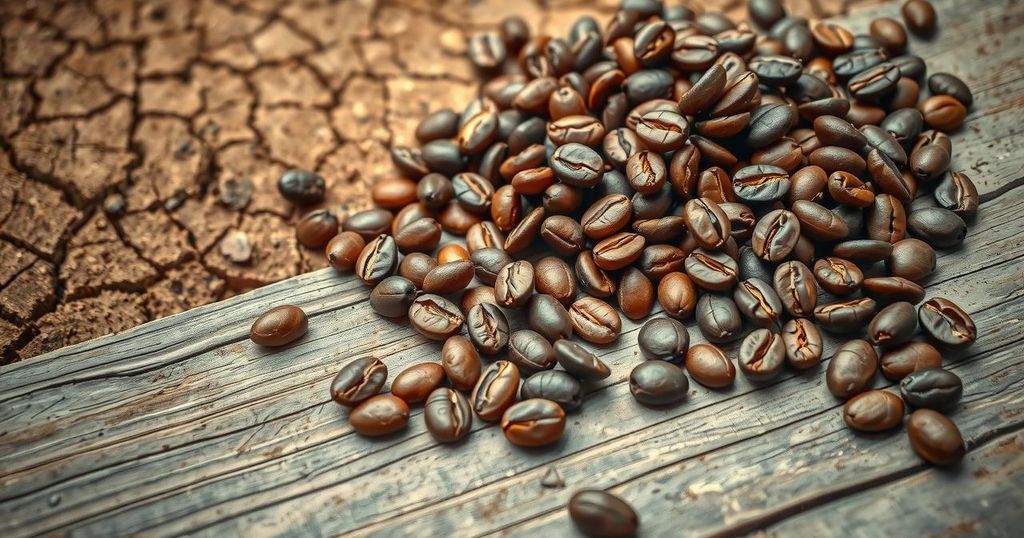Insufficient Rain in Brazil Supports Coffee Prices

Insufficient rainfall in Brazil, strong currency, and reduced exports are uplifting coffee prices, particularly for arabica. Concerns over future production due to drought conditions are persistent, while robusta coffee faces pressures from increased Vietnamese exports. Overall, coffee supply dynamics continue to evolve amidst broader global market challenges.
On Wednesday, May arabica coffee (KCK25) increased by 1.89%, closing at +7.25, while May ICE robusta coffee (RMK25) saw a rise of 1.06%, closing at +58. The rise in coffee prices is attributed to prolonged dry conditions in Brazil and the strengthening Brazilian real, which discouraged producers from exporting. According to Somar Meteorologia, Brazil’s leading arabica-producing region, Minas Gerais, received only 30.8 mm of rain in the week ending March 15, which is 71% of the historical average.
Robusta coffee gains were moderated by increased global supply as ICE-monitored inventories grew to a one-week high of 4,336 lots. In contrast, ICE-monitored arabica inventories fell to a 3.5-week low of 782,648 bags. Concerns regarding long-term supply continue to push coffee prices higher. Cecafe reported a 12% year-on-year decrease in Brazil’s February green coffee exports, totaling 3 million bags. Furthermore, Conab forecasts a 4.4% year-on-year decline in Brazil’s 2025/26 coffee crop, projecting it at a three-year low of 51.81 million bags.
Despite these factors, a report from Marex Solutions predicts an increase in the global coffee surplus for the 2025/26 season to 1.2 million bags, up from 200,000 bags in the 2024/25 season. Additionally, robusta coffee prices face pressure from rising exports in Vietnam, the world’s leading robusta producer, which saw a 6.6% year-on-year increase in February coffee exports, totaling 169,000 metric tons.
The continuing dry El Nino conditions in South and Central America pose risks for future crops. Since last April, Brazil’s rainfall has consistently fallen below average, adversely affecting coffee trees during critical blooming periods. Cemaden has noted that Brazil is experiencing its driest weather since 1981, while Colombia, the second-largest arabica producer, is slowly recovering from last year’s drought.
Robusta coffee prices are bolstered by limited production due to drought conditions affecting Vietnam’s output. The 2023/24 crop year production in Vietnam decreased by 20% to 1.472 million metric tons. The USDA FAS projects a slight decrease in Vietnam’s robusta production in the upcoming 2024/25 marketing year, as well as a reported 17.1% year-on-year drop in coffee exports in 2024.
Conversely, reports of growing global coffee exports suppress prices. Conab noted a record 50.5 million bags in 2024 coffee exports from Brazil, a 28.8% year-on-year increase. However, ICO reported a decrease in global coffee exports for December, dropping 12.4% year-on-year and showing a slight decline in total global exports from October to December.
The USDA’s recent biannual report presents mixed forecasts for coffee prices, projecting an overall rise in world coffee production by 4% year-on-year for 2024/25. Arabica production is expected to increase by 1.5% while robusta production may rise by 7.5%. Despite this, ending stocks for 2024/25 are projected to fall by 6.6% to a 25-year low.
Further assessment of Brazil’s coffee production prospects for 2025/26 reveals Volcafe’s estimate has been reduced by approximately 11 million bags due to severe drought conditions, projecting a global deficit of 8.5 million bags in arabica coffee, signaling the fifth consecutive year of deficits.
In conclusion, the coffee market is currently influenced by various factors including insufficient rainfall in Brazil, the strength of the Brazilian real, and changing export dynamics. Concerns about production declines and the effects of drought present significant challenges for both arabica and robusta varieties, contributing to upward pressure on prices. The mixing signals of increased global production and exports will also play a role in shaping the future landscape of coffee prices.
Original Source: www.nasdaq.com







